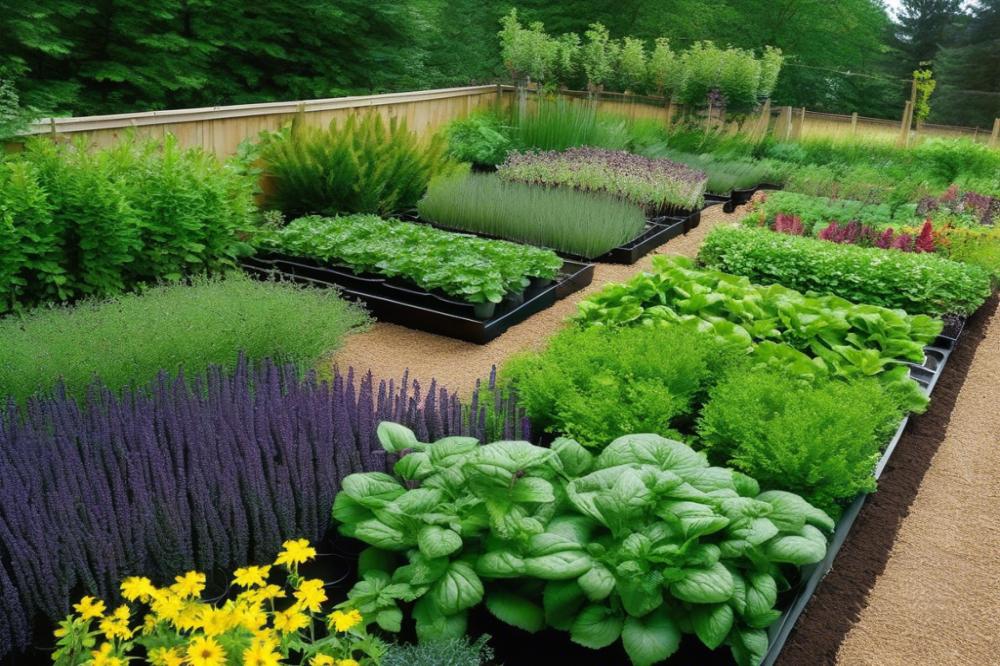Importance of Herbs in culinary gardens
Herbs play a vital role in enhancing the flavor of dishes in a culinary garden. Aromatic plants like basil, thyme, and parsley can transform even the most straightforward recipes. Their presence can elevate meals, providing freshness and complexity. Growing these plants at home not only adds taste but also a personal touch to cooking. Having access to fresh herbs means using them at their peak flavor and aroma.
Role of Fertilizers in Herb Growth


Fertilizers serve as the backbone for promoting vibrant herb growth. These essential substances provide important nutrients that plants need to thrive. Understanding the right balance of nitrogen, phosphorus, and potassium can significantly impact the health and yield of your herbs. Each nutrient has a specific role; nitrogen supports leafy growth, phosphorus encourages strong roots, and potassium enhances overall vigor. A well-balanced approach to nutrient management ensures that your herbs flourish.
Overview of herb fertilizers and Their Benefits


Various types of fertilizers exist to support your herb care routine. organic fertilizers, for example, enrich the soil while promoting soil health. They break down slowly, offering a steady release of nutrients over time. Liquid feeds can be an excellent choice for a quick nutrient boost, allowing herbs to absorb vitamins rapidly. Compost is another beneficial option, providing a natural way to improve soil quality and moisture retention.
Using these different types of fertilizers enables you to tailor your garden’s needs. Optimal growth enhancement can lead to a more bountiful herb harvest, ready for seasoning meals. A thoughtful approach to fertilizers ultimately leads to stronger, more flavorful plants, ensuring that your culinary garden thrives.
Understanding herb fertilizers


Fertilizers designed specifically for herbs play a crucial role in enhancing the growth and flavor of your culinary garden. They provide essential nutrients that plants need to thrive. These nutrients help in developing strong roots, vibrant leaves, and robust flavors in the herbs you grow.
Three key nutrients are vital for herb growth: nitrogen, phosphorus, and potassium. Nitrogen promotes healthy foliage, encouraging lush green growth. Phosphorus is important for root development and flowering. Potassium aids in overall plant health, helping to regulate various processes within the plants. Together, these nutrients contribute to the vibrant life of your garden.
When it comes to fertilizers, the choice largely comes down to organic and synthetic options. organic fertilizers, like compost or well-rotted manure, enrich the soil naturally. They improve soil health by adding organic matter and enhancing beneficial microbial activity. In contrast, synthetic fertilizers typically provide nutrients in a more concentrated form. While they can deliver quick results, they do not always support long-term soil health.
Liquid feeds also serve as a popular option for herb care. These fertilizers can be applied directly to the leaves or soil, providing a fast source of nutrients. Additionally, using organic methods offers a gentler approach. They release nutrients slowly, making them accessible over time, and reducing the risk of nutrient runoff or burning the plants.
Nutrient management is key for any gardener. Regularly testing the soil can help determine what your herbs might be lacking. Adjusting fertilizer types based on your plants’ needs can enhance growth and flavor. Remember, healthy soil contributes to thriving herbs, leading to a more flavorful cooking experience.
Choosing the Right Fertilizer for Herbs


When selecting the appropriate fertilizer for your herbs, several important factors come into play. First, consider the type of herbs you are growing. Different varieties have unique nutritional needs. Certain plants thrive on higher nitrogen, while others may require more phosphorus or potassium. Understanding their requirements can help you make better choices.
The growth stage of your herbs is another crucial factor. Seedlings benefit from a different nutrient profile than mature plants. During early growth, a fertilizer with higher nitrogen promotes leafy development. In contrast, flowering herbs may need additional phosphorus to enhance blooms. Adjust your fertilizing strategy accordingly to match these stages.
Soil health cannot be overlooked when managing your herbs. Testing your soil can reveal nutrient levels and pH balance, guiding your decisions. Healthy soil often contains essential microorganisms that assist nutrient uptake. By fostering a balanced environment, you set up your plants for success.
Types of Herb Fertilizers
You may come across several types of herb fertilizers, including granular and liquid feeds. Granular options release nutrients slowly, providing a steady supply over time. They are simple to apply and often last longer between applications. Liquid feeds, on the other hand, deliver nutrients quickly. This can be beneficial for fast-growing herbs that need a boost during peak growth.
Compost adds another dimension to herb care. Rich in organic matter, it improves soil structure while supplying a broad range of essential nutrients. Utilizing compost helps build sustainable practices in your culinary garden.
Benefits of Organic Fertilizers Over Synthetic
Organic fertilizers hold several advantages compared to synthetic alternatives. They typically enhance soil health and promote beneficial microbial life. This adds more nutrients over time, leading to a sustainable gardening approach. Organic choices also minimize the risk of chemical runoff that can harm the environment.
Nitrogen, phosphorus, and potassium are key components in many organic blends. These nutrients support various plant functions. A consistent supply can enhance growth and improve flavor in your herbs. You can feel good knowing that organic fertilizers nourish both your plants and the earth.
Nutrient Management for Herbs
Understanding the roles of nitrogen, phosphorus, and potassium is essential for anyone passionate about herb cultivation. These three nutrients, often referred to as N-P-K, play vital roles in the growth of plants. Nitrogen supports leafy growth, making it crucial for herbs like basil and parsley. Phosphorus aids in root development and flower production, which can enhance the flavor of herbs. Lastly, potassium strengthens overall plant health and helps in stress resistance.
Balancing nutrients for optimal growth enhancement is key in achieving a thriving culinary garden. While nitrogen promotes lush foliage, too much of it can lead to weak stems and lower essential oils in herbs. Providing an appropriate ratio of nutrients tailored to the specific needs of each herb variety will lead to healthier plants. Using organic fertilizers, like compost and liquid feeds, can naturally supply these necessary nutrients while improving soil health.
The importance of soil testing for nutrient needs cannot be overstated. Testing your soil gives you insights into what is present and what may be lacking. It guides you in nutrient management decisions, ensuring that you provide just the right amount of each element. Regular soil testing helps avoid over-fertilizing, which can harm plants and local wildlife.
Monitoring the nutrient levels in your garden encourages sustainable herb care practices. Healthy soil leads to stronger plants that not only survive but thrive. Adjusting your approach based on soil composition keeps your herbs productive and flavorful. When you understand and manage these elements effectively, you can harvest fresh, vibrant flavors right from your garden.
Application Techniques for Herb Fertilizers
Applying fertilizers in your culinary garden requires some consideration. Start by understanding the needs of your herbs. Different plants have varying nutrient requirements, and their growth can be influenced by how and when you apply fertilizers.
Best Practices for Applying Fertilizers
Follow the guidelines carefully to get the best results. Spread granular organic fertilizers evenly around the base of the plants. Use a rake or your hands to avoid concentrating the nutrients in one spot. Mixing the fertilizer into the top layer of soil enhances its absorption. This promotes better growth and improves soil health.
Timing and Frequency of Fertilizer Application
Timing is crucial in maintaining herb vitality. Fertilize at the beginning of the growing season, when plants are just waking up. You can reapply every four to six weeks during peak growth periods. However, once the plants start to flower, cut back on the feed. Too much nitrogen at this stage can lead to lush foliage but may reduce herb flavor.
How to Incorporate Compost and Liquid Feeds Effectively
Compost is one of nature’s finest fertilizers. Adding well-rotted compost can improve both soil health and nutrient levels. Spread a thin layer on the soil surface and mix it in lightly. Liquid feeds also play a significant role in herb care. Dilute them according to instructions before applying. This method allows for quick nutrient uptake, leading to growth enhancement.
Managing nutrients effectively requires attention. Always observe your plants for signs of nutrient deficiencies or excesses. Adjust your fertilization strategy accordingly. Remember, a balanced diet of nitrogen, phosphorus, and potassium will keep your herbs thriving and flavorful.
Maintaining Soil Health
Soil health plays a crucial role in the successful growth of herbs. Healthy soil directly impacts how well plants can absorb nutrients, water, and oxygen. In turn, this affects their overall vitality and flavor. When soil is rich in organic matter, it not only supports plant roots but also fosters beneficial microorganisms. These small organisms are essential for breaking down organic material, which leads to improved growth enhancement.
Techniques for Improving Soil Quality
Various techniques can greatly enhance soil quality. One effective method is mulching, which involves covering the soil’s surface with organic material. This practice prevents weeds while retaining moisture. In addition, the decomposition of mulch adds valuable nutrients to the soil over time. Another technique is using cover crops during the off-season. These crops protect the soil from erosion and enrich it by fixing nitrogen. Their roots help break up compacted soil, promoting better drainage and airflow.
The Role of Compost in Enhancing Soil Fertility
Compost is a powerhouse for enhancing soil fertility. By combining kitchen scraps, yard clippings, and other organic matter, you can create a nutrient-rich amendment. This mixture introduces important elements like nitrogen, phosphorus, and potassium back into the soil. Regularly adding compost not only boosts fertility but also helps in nutrient management. As a result, your culinary garden will thrive with robust herbs ready to flourish in your meals. For easy use, liquid feeds derived from compost can provide quick benefits to thirsty plants.
Herb Care Beyond Fertilizers
Keeping your culinary garden thriving relies on more than just herb fertilizers. Proper watering is essential for healthy plants. Overwatering can lead to root rot, while underwatering causes wilting. Establish a consistent routine based on your local climate and the specific needs of your herbs. Sunlight also plays a significant role in their growth. Most culinary herbs prefer full sun, which usually means at least six hours of direct light each day. Finding the right spot for each herb ensures they receive the energy necessary for robust growth.
Pest and disease management strategies are vital in maintaining a flourishing herb garden. Regularly inspecting plants for signs of trouble can help catch problems early. Common pests like aphids and spider mites can be managed with natural insecticidal soaps or neem oil. Likewise, diseases often stem from poor air circulation or crowded plants. Pruning and spacing help prevent these issues while promoting overall soil health. Remember, healthier plants are less susceptible to infestations.
Sustainable gardening practices enrich your garden while complementing your fertilization efforts. Using organic fertilizers, such as compost or well-rotted manure, improves soil quality over time. These resources provide essential nutrients like nitrogen, phosphorus, and potassium, which support growth enhancement. Liquid feeds can also be applied during the growing season to give your herbs a nutrient boost. Practicing crop rotation and companion planting further promotes nutrient management. These strategies build resilience within your garden ecosystem and reduce reliance on synthetic inputs.
Final Thoughts on Herb Fertilization
In summary, selecting the right fertilizers is essential for growing vibrant and flavorful herbs. Nutrient balance plays a crucial role in this process. Most herbs thrive with fertilizers that contain low amounts of nitrogen. This helps encourage the essential oils that give herbs their unique flavors. Additionally, organic fertilizers can provide a gentle, steady source of nutrients over time.
Maintaining a culinary garden requires attention to soil quality, watering, and light exposure. Frequent testing of soil can help you understand what nutrients might be lacking. Always consider incorporating compost to enrich the earth and support robust growth. Your herbs will appreciate the extra care and attention.
Take the time to explore different fertilization methods. From traditional compost to liquid solutions, various options exist that can enhance herb health. Experimentation will lead you to discover what works best for your specific garden. Each herb may have its preferences, so stay observant and adjust as needed.
With a little effort, your culinary garden can flourish. Invest in quality fertilizers, observe your plants, and enjoy the satisfaction that comes from nurturing them. Happy gardening!



